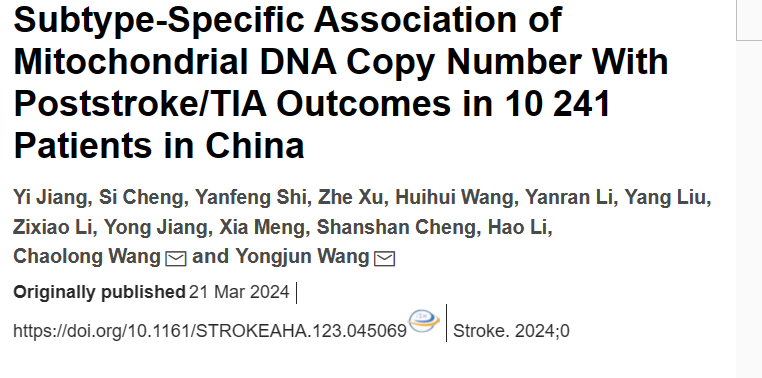On March 21, 2024, Prof. WANG Chao-Long's team from School of Public Health, Tongji Medical College, Huazhong University of Science and Technology, in collaboration with Prof. WANG Cong-Jun 's team from Beijing Tiantan Hospital (Dr. JIANG Yi and Dr. CHENG Shi are the co-first authors), published a paper in the prestigious medical journal Stroke on the "Subtype-specific association of mitochondrial DNA copy number with post-stroke/TIA outcomes in 10,248 patients. Subtype-specific association of mitochondrial DNA copy number with post-stroke/TIA outcomes in 10,241 patients in China". Based on the largest stroke cohort in China, the study found that mitochondrial DNA copy number (mtDNA-CN) was associated with stroke recurrence, disability, and all-cause mortality, and that these associations were only significant in specific age groups and stroke subtypes. This study reveals the potential value of mtDNA-CN as a biomarker of stroke prognosis, highlights the importance of stratifying stroke subtypes, and promotes the study of stroke prognostic mechanisms, which is an important guideline for improving the prognosis of stroke patients in the future.

Mitochondrial DNA copy number (mtDNA-CN) is associated with the severity and mortality in patients with stroke, but the associations in different stroke subtypes remain unexplored.We conducted an observational prospective cohort analysis on patients with ischemic stroke or transient ischemic attack enrolled in the Third China National Stroke Registry. We applied logistic models to assess the association of mtDNA-CN with functional outcome (modified Rankin Scale score, 3–6 versus 0–2) and Cox proportional hazard models to assess the association with stroke recurrence (treating mortality as a competing risk) and mortality during a 12-month follow-up, adjusting for sex, age, physical activity, National Institutes of Health Stroke Scale at admission, history of stroke and peripheral artery disease, small artery occlusion, and interleukin-6. Subgroup analyses stratified by age and stroke subtypes were conducted.The Third China National Stroke Registry enrolled 15 166 patients, of which 10 241 with whole-genome sequencing data were retained (mean age, 62.2 [SD, 11.2] years; 68.8% men). The associations between mtDNA-CN and poststroke/transient ischemic attack outcomes were specific to patients aged ≤65 years, with lower mtDNA-CN significantly associated with stroke recurrence in 12 months (subdistribution hazard ratio, 1.15 per SD lower mtDNA-CN [95% CI, 1.04–1.27]; P=5.2×10−3) and higher all-cause mortality in 3 months (hazard ratio, 2.19 [95% CI, 1.41–3.39]; P=5.0×10−4). Across subtypes, the associations of mtDNA-CN with stroke recurrence were specific to stroke of undetermined cause (subdistribution hazard ratio, 1.28 [95% CI, 1.11–1.48]; P=6.6×10−4). In particular, lower mtDNA-CN was associated with poorer functional outcomes in stroke of undetermined cause patients diagnosed with embolic stroke of undetermined source (odds ratio, 1.53 [95%CI,1.20–1.94]; P=5.4×10−4), which remained significant after excluding patients with recurrent stroke (odds ratio, 1.49 [95% CI, 1.14–1.94]; P=3.0×10−3).Lower mtDNA-CN is associated with higher stroke recurrence rate and all-cause mortality, as well as poorer functional outcome at follow-up, among stroke of undetermined cause, embolic stroke of undetermined source, and younger patients.
Paperlink:https://pubmed.ncbi.nlm.nih.gov/38511332/
